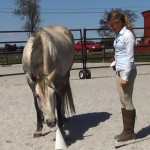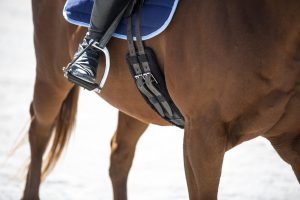Clicker training has become quite popular in dog training in recent years, and with good reason. It is a system of training based on science and learning theory. Unfortunantly, it hasn’t caught on with many horse owners yet.
Clicker training involves training through positive reinforcement, meaning when the horse does the correct “behavior” he is reinforced or rewarded by something good – such as food. The clicker serves as a “marker” or a “bridge signal” telling the horse “that’s right!” at precisely the moment he does the right thing. With just a little bit of conditioning the horse learns to equate the click with food, and this is exactly what I focus on in this video – I have been using positive reinforcement training for some time (see this post Using Treats in Training), but I had always used the word “good” instead of the clicker. It works the same, but I am finding that the clicker has an advantage in some cases because it is a very unique and distinctive sound.
I don’t use only clicker training when I work with my horses, but I have found that it is a very useful tool or training skill to have. It is fun for the horse and puts them in a completely different state of mind than many traditional methods because the horse is actively searching for the right answer and knows he will get a reward when he finds it – so there is real motivation for the horse to figure out what I want. I am still honing my skills in this method, but I highly recommend these two books by Karen Pryor and you can read my reviews on them with the links below.
Reaching the Animal Mind
Don’t Shoot the Dog
Watch the video and then it’s your turn – have you used clicker training on your horse (or another animal)? When did you use this method?














21 Responses
Thanks Callie! I love watching all your videos. They are full of valuable information yet concise. I can’t wait for the next one.
Thanks Cheryl!
Hi Callie,
It’s been a while since I’ve posted, but really felt I had to post for this video because I enjoyed it so much and also because it felt like you read my mind as far as my hope that you would put your “seal of approval” on the concept of using clicker training for horses! I’ve been intrigued with clicker training for a long time and have “dabbled” with it a bit with Shadow. He loves it because he is very playful and is highly food motivated. I find it also helps him relax as he can sometimes become tense and nervous while training. It’s seems like when we add in the clicker/food it distracts him from worrying about “doing the right or wrong thing” and he has more fun. However, I’ve been a little hesitant to get too involved in clicker training without knowing that a trusted horse person such as yourself embraces the method and also because I’ve been unsure how to progress with it. I would love if you could do more videos on clicker training and especially if you could show how you might use clicker training for saddle work. For instance, I could see it being very useful for work with the mounting block but I also have a strong feeling that it could be used way beyond that but struggle with exactly how. For instance, I would love to see you do some videos on using clicker training throughout the “traditional” training you showed in your Balanced Riding Course – how to use clicker training for training go, whoa, transitions, turning, backing, leg yield, etc. under saddle. I have always been fascinated with the possibility of using clicker training as I progress through the training pyramid but really need some guidance of how to do that! Thank you so much for this video – I am really excited to see more on this subject!! As always, thanks so much for all of your hard work and dedication with your videos!! Margaret
Hi Margaret!
Glad you enjoyed this video! I will certainly have more videos to share on clicker training as I continue experimenting with it myself and finding more ways to incorporate it. Just this weekend, I hosted a clinic at my farm with Angelo Telatin, who is very skilled at not just clicker training, but training through learning theory in general. I know I learned a lot as did everyone there. I believe the clicker does have good applications under saddle, but it can be a bit cumbersome riding with the clicker, especially through more advanced work. The most success I have had with it under saddle is with a horse that hated going forward and would pin her ears and try to stop when trotting. I started by clicking for any forward transition, then clicking for forward ears and a nice expression. Within a few sessions she was trotting around happily!
Great video on a subject I’ve been interested in trying with my own horse! My question is, how did you introduce the tap-and-step towards exercises? Thanks!
Hi Nancy, I start with standing the horse along a fence (this blocks swinging the hips out) then start tapping their haunch – just enough to be annoying, but not stressful. As soon as the hip comes in at all – in the beginning it may be just a lean or one timy step, I stop tapping, say good (or click) and treat. As they start to understand, I gradually raise the criteria by asking for more steps. However, they will usually just offer more steps as soon as they understand what is expected. Hope this helps! Callie
Hi callie. Im so glad you agree with treats. Ive worked alot with treats with fancy its always helped.. a gf had trouble at the mounting block, he would scoot away then she tries treats… It make the horse turn in ward so she had a better stand with him and no chance of him not taking off with her.. good video. Nells a good boy standing like a gentelman the whole time. Love your horsemanship! See you soon
Hi Tammy, Nell was great, loves the camera, haha!
Hi Callie,
Just wondering if you could briefly explain why you’d want to train a horse to step into the whip rather than away from it?
Thank you,
Dallas in State College, PA
Hi Dallas, The main reason is that I am doing in hand work and wanted a way to cue my horse to do a haunches in from the ground. Second it was kind of a demonstration to myself how most of our horses behaviors are learned, meaning it is almost as easy to teach them to step into the whip rather than away depending on how we set them up and when we release and reward.
Clicker training can certainly bridge the communication gap between the horse and owner. The downside is that it will take longer for your horse to learn, if you’re not showing the horse what its doing wrong. I believe in a more balanced approach to horse training that yields faster results. Although clicker training is a wonderful tool. Thanks for the great article!
http://www.horsesrevealed.com
Hello again Callie!
I haven’t posted in awhile either, but I was encouraged to by reading Margaret’s post. I have recently ordered some specific literature on clicker training for horses, but wondered what ‘method’ or who’s instruction you have been using. I have used clicker training for years with my parrots and the basics, of course, are the same across all living species. However, it is a bit different with a horse as you may actually be riding the animal while you’re working with them. I’m with Margaret on this….give us more :>) I would love it if you would share your journey as you begin to use clicker training more with your horses.
-Brooks
Hi Brooks! I will certainly be sharing a lot! You will see many new videos within this next round of the Balanced Riding Course about operant conditioning and the clicker training as well! I really like Shawna Karrash. She has many videos on youtube and a subscription site that I am a part of as well. I have learned a lot of what I do with the clicker from Shawna and also from Angelo Telatin. He did a clinic at my farm in May specifically on using operant conditioning with horses. I wish you all lived closer so you could have attended, but some of that footage will be in the course as well!
I have watched clicker training on You tube. I was fascinated by what the horses were willing to learn for a treat. Although I have wanted to try it I have hesitated because my horse is mouthy. After watching Callie only give the treat when the horses head is facing away I might give it a try. I also like the suggestion that treats be earned.
I am also interested in Liberty training and Horseagility. I haven’t tried it, just interested. Its amazing what horses can learn, You have to love them
Hello!
I’m a second time beginner, if that makes sense. I took riding lessons as a young teen for a couple years, and really hadn’t ridden since. Now, as a middle aged adult, horses have magically come into my life again! I couldn’t be happier. I’ve found your videos very useful, so thank you. Canine behavior was an unofficial specialty of mine when I was working as a veterinary technician. I am a huge proponent of clicker training, because they so precisely indicate the desired behavior. One of my first horse questions was “Why am I not using the clicker with horses?” Glad to see it happens!
Hi Paula, Welcome back to riding! I am sure you will find many parallels between training dogs and horses. Getting my first puppy and learning more about canine behavior and training was actually what got me interested in using the clicker with the horses too!
Yes fantastic, it’s great to do things with the horses on the ground too. I love it. A horse friend of mine uses clicker training with all of her horses. Even her young brumbies. It is fantastic to watch. My children even do it too with my friends horses and enjoy it very much. I like the clicker or good, we also just click with our mouth as to not have the clicker in our hand.
Also, how do you get your horse to stand there happily next to you… when you are talking, not giving them a treat or anything. Looks good, I get confused when it’s ok not to treat them so they also know they are doing the what we like them too. Ie. happily stand there.
Hi Casey,
Good question, I learned early on when starting to work with clicker training to make standing still the horse’s “default” behavior by randomly rewarding remaining still.
Hi do you have any videos on how to start treating so they take their head away? I’m working with a very mouthy pushy horse with picking up feet problems. Hoping to learn clicker training to start making the horse more comfortable, teach better behavior. Thank you so much, I really enjoy your videos
Hi Kate! We don’t have one on that topic here on the blog but you want to click and treat when they take their head away from you and feed them away from your body. If he is mouthy when you go to give him the food you can hold it at his nose until he stops mouthing and then give it to him!
I hope this helps 🙂
-Julia Burdy, CRK Training Community Manager